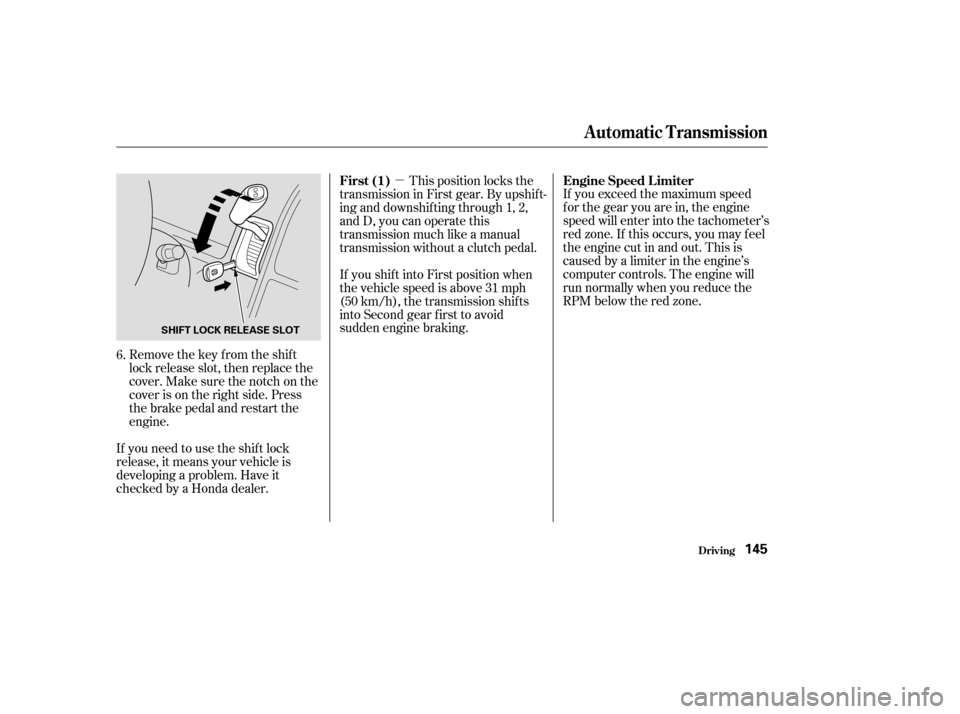Page 147 of 256
�µ
�µ Use Neutral if you
need to restart a stalled engine, or if
it is necessary to stop brief ly with
the engine idling. Shif t to the Park
position if you need to leave your
vehicle for any reason. Press on the
brake pedal when you are moving
the shift lever from Neutral to
another gear.
Use this position f or
your normal driving. The transmis-
sion automatically selects a suitable
gear f or your speed and acceleration.
You may notice the transmission
shif ting up at higher speeds when
the engine is cold. This helps the
engine warm up f aster. TheOver-drive(O/D)ison
whenever you turn the ignition to
ON (II). Pressing the O/D switch on
the edge of the shif t lever to turn it
of f ; the O/D OFF indicator comes
on.Over-drivecanbeturnedonoroff
only when the ignition switch is in
the ON (II) position and the shif t
lever is in any position.
CONT INUED
Neutral (N)
Drive (D)Over-drive (O/D) Mode
Automatic Transmission
Driving143
OVER-DRIVE OFF INDICATOR
Page 148 of 256

�µ
WhentheOver-driveisoff,the
transmission selects only the f irst
three gears. Use it to provide engine
braking when going down a steep hill,
or keep the transmission f rom
cycling between third and f ourth
gears in stop-and-go driving.
This position locks
the transmission in second gear. It
does not downshif t to f irst gear
when you come to a stop.
Use Second gear:
For more power when climbing.
To increase engine braking when
going down steep hills.
For starting out on a slippery
surf ace or in deep snow.
To help reduce wheel spin. When driving downhill with a
trailer.
Do this if pushing on the brake pedal
and pulling the shif t lever does not
shif t the transmission out of Park: Set the Parking brake.
Make sure the ignition switch is in
the LOCK (0) position.
To release the reverse lockout,
make sure the ignition switch is in
the ACCESSORY(I) position.
Put a cloth on the edge of the shif t
lock release slot cover next to the
shif t lever. Using a key, caref ully
pry on the edge of the cover to
remove it. Insert a key into the shift lock
release slot.
To release the reverse lockout,
move the shift lever from Neutral
to Reverse, then to Park. Push down on the key and move
the shift lever out of Park to
Neutral.
1.
2.
3.
4.
5.
Second (2)
Shif t L ock Release
Automatic Transmission
Driving144
COVER
Page 149 of 256

�µIf you exceed the maximum speed
f or the gear you are in, the engine
speed will enter into the tachometer’s
red zone. If this occurs, you may f eel
the engine cut in and out. This is
caused by a limiter in the engine’s
computer controls. The engine will
run normally when you reduce the
RPM below the red zone.
This position locks the
transmission in First gear. By upshif t-
ing and downshif ting through 1, 2,
and D, you can operate this
transmission much like a manual
transmission without a clutch pedal.
If you shif t into First position when
the vehicle speed is above 31 mph
(50 km/h), the transmission shif ts
into Second gear f irst to avoid
sudden engine braking.
Remove the key from the shift
lock release slot, then replace the
cover. Make sure the notch on the
cover is on the right side. Press
the brake pedal and restart the
engine.
If you need to use the shif t lock
release, it means your vehicle is
developing a problem. Have it
checked by a Honda dealer. 6. Engine Speed L imiter
First (1)
Automatic Transmission
Driving145
SHIFT LOCK RELEASE SLOT
Page 150 of 256

Always use the parking brake when
you park your vehicle. Make sure
the parking brake is set f irmly or
your vehicle may roll if it is parked
on an incline.
If your vehicle has an automatic
transmission, set the parking brake
bef ore you put the transmission in
Park. This keeps the vehicle f rom
moving and putting pressure on the
parking mechanism in the
transmission.Make sure the moonroof and the
windows are closed.
Turn of f the lights.
Place any packages, valuables, etc.
in the cargo area, or take them
with you.
Lock the doors and the tailgate.
Make sure the hatch glass is
closed securely.
Never park over dry leaves, tall
grass, or other f lammable
materials. The hot three way
catalytic converter could cause
these materials to catch on fire.If the vehicle is f acing uphill, turn
the f ront wheels away f rom the
curb.
If the vehicle is f acing downhill,
turn the front wheels toward the
curb.
Make sure the parking brake is
f ully released bef ore driving away.
Driving with the parking brake
partially set can overheat or
damage the rear brakes.
Parking T ips
Driving
Parking T ips
146
Page 151 of 256

Your Honda is equipped with disc
brakes at all f our wheels. A power
assist helps reduce the ef f ort needed
on the brake pedal. The ABS (on
vehicles equipped with ABS) helps
you retain steering control when
braking very hard.
Resting your f oot on the pedal keeps
the brakes applied lightly, builds up
heat, and reduces their ef f ectiveness.
It also keeps your brake lights on all
the time, conf using drivers behind
you.Constant application of the brakes
when going down a long hill builds
up heat and reduces their ef f ective-
ness. Use the engine to assist the
brakes by taking your f oot of f the
accelerator and downshif ting to a
lower gear.
Check your brakes af ter driving
through deep water. Apply the
brakes moderately to see if they f eel
normal. If not, apply them gently and
f requently until they do. Be extra
cautious and alert in your driving.
The hydraulic system that operates
the brakes has two separate circuits.
Each circuit works diagonally across
the vehicle (the lef t-f ront brake is
connected with the right-rear brake,
etc.). If one circuit should develop a
problem, you will still have braking
at two wheels.
Braking System
Driving
Braking System Design
147
Front
Page 152 of 256

If the brake pads need replacing, you
will hear a distinctive, metallic
screeching sound when you apply
the brake pedal. If you do not have
the brake pads replaced, they will
screech all the time. It is normal f or
the brakes to occasionally squeal or
squeak when you apply them.The ABS also balances the f ront-to-
rear braking distribution according
to vehicle loading.
this def eats the purpose of the ABS.
Let the ABS work f or you by always
keeping f irm, steady pressure on the
brake pedal as you steer away from
the hazard. This is sometimes
ref erred to as ‘‘stomp and steer.’’You will f eel a pulsation in the brake
pedal when the ABS activates, and
you may hear some noise. This is
normal: it is the ABS rapidly
pumpingthebrakes.Ondry
pavement, you will need to press on
thebrakepedalveryhardbeforethe
ABS activates. However, you may
feel the ABS activate immediately if
you are trying to stop on snow or ice.
The Anti-lock Brake System (ABS)
helps prevent the brakes f rom
locking up and helps you retain
steering control by pumping the
brakes rapidly, much f aster than a
person can do it.
You should never pump the brake pedal;
Standard f or EX model in the U.S., and
EX and EX-L models in Canada
Driving
Brake Wear Indicators Anti-lock Brakes
Braking System, Anti-lock Brakes (ABS)
148
Page 153 of 256

�Î
�Î
The ABS is self -checking each time
the vehicle is started and moved.
The ABS indicator will come on if
anything goes wrong. If the ABS
indicator comes on, the brakes still
work like a conventional system, but
without anti-lock. You should have a
dealer inspect your vehicle as soon
as possible. it only helps with steering
control during braking. You should
always maintain a saf e f ollowing
distance f rom other vehicles.
such as trying to take a
corner too f ast or making a sudden
lane change. Always drive at a safe,
prudent speed f or the road and
weather conditions.
Always steer moderately
when you are braking hard. Severe
or sharp steering wheel movement
can still cause your vehicle to veer
into oncoming traffic or off the road. on loose or
uneven surf aces, such as gravel or
snow, than a vehicle without anti-
lock. Slow down and allow a greater
distance between vehicles under
those conditions.
Anti-lock Brakes (ABS)
Driving
ABS Indicator A BS does not reduce the time or
distance it takes to stop the
vehicle;
A BS will not prevent a skid that
results f rom changing direction
abruptly,
A BS cannot prevent a loss of
stability.A vehicle with A BS may require a
longer distance to stopImport ant Saf et y Reminders
149
ABS INDICATOR
U.S. indicator shown
Page 156 of 256

Towing generally requires a variety
of supplemental equipment. To
ensure the best quality, we
recommend that you purchase
Honda equipment whenever possible.
Discuss any additional needs with
your trailer sales or rental agency,
and make sure all equipment is
properly installed, maintained, and
also meets state regulations.Any hitch used on your vehicle must
be properly bolted to the underbody.
Always use saf ety chains. Make sure
they are secured to both the trailer
and hitch, and that they cross under
the tongue so they can catch the
trailer if it becomes unhitched.
Leave enough slack to allow the
trailer to turn corners easily, but do
not let the chains drag on the ground.
There are two common types of
trailer brakes: surge and electric.
Surge brakes are common f or boat
trailers, since the brakes will get wet. Honda requires that any trailer with
a total trailer weight of 1,000 lbs (455
kg) or more have its own brakes.
Electric brakes must be
electronically actuated. Do not
attempt to tap into your vehicle’s
hydraulic system. See your brake
manuf acturer f or more inf ormation
on installing electric brakes.
Towing a Trailer
Driving
T owing Equipment and
A ccessoriesHitches
Saf et y Chains Trailer Brakes
152